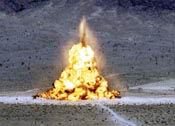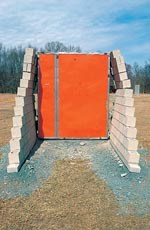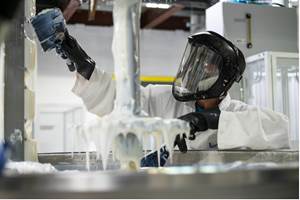Blast protection for large structures
Hardening of public buildings against terrorist threats represents a potentially huge market for antiballistic composites.
In the wake of the Sept. 11, 2001 terrorist attacks in the U.S., security systems of all types continue to be in great demand. The already well-established body armor market took a large turn upward, both in military and civilian law-enforcement applications, as security forces the world over retooled policy and equipment to meet the new threat. Publicity surrounding the lack of armor on many military ground vehicles used in current U.S. military operations in Iraq has spurred significant activity in both lightweight add-on composite armor kits for fielded vehicles and "up-armoring" strategies, in which composite armor is designed into new vehicles and installed on the assembly line (see "Composites on the Frontlines," HPC January 2005, p. 26). On the home front, however, buildings and other critical structures also are being hardened to protect against blast damage. Composites are a key component of blast hardening and, owing to the sheer size of the structures for which protection must be provided, present a large and significant potential market for a unique class of retrofittable antiballistic and blast-containment materials.
One new product is a blast-resistant panel called LIFE SHIELD, developed by B & H Coatings Inc. (Salisbury, Md.), made from a nonwoven reinforcing fiber grid in a matrix of polyurea. The fiber grid, a MeC-GRID product, is manufactured by TechFab LLC (Anderson, S.C.), a spinoff of Hexcel Schwebel, using Twaron, Technora and Technora-hybrid fibers manufactured by Teijin Twaron BV (Arnhem, The Netherlands). Twaron is the company's standard para-aramid fiber and, along with Kevlar from Dupont Advanced Fiber Systems (Richmond, Va.), represents one of the most commonly used fibers in antiballistic applications. Technora is Teijin's unique para-aramid variant, which possesses higher tensile strength and greater elongation than the standard fiber, at an equivalent density.
TechFab makes the grid in a proprietary process that aligns warp and weft fibers wet out with a urethane coating in an open mesh structure, which is then cured. The coating is compatible with the spray-applied Sherwin-Williams General Polymers (Cleveland, Ohio) polyurea resin, which forms a 90-mil-thick skin on either side of the fiber mesh. The completed modular panels, less than 25.4-mm/1-inch thick, can be mechanically fastened to walls to contain blast effects and prevent fragments from injuring building occupants. The panels have been tested successfully at the U.S. Army's Aberdeen Test Center and are currently installed at an unnamed facility, says developer Bruce Hall.
New homeland security rules are, in some cases, mandating building upgrades. Structural Preservation Systems Inc. (Hanover, Md.), a specialty repair contractor known for its use of fiberglass and carbon composites for concrete repair and rehab, has used Hardwire high-tensile steel wire reinforcement, made by Hardwire LLC (Pocomoke City, Md.), in the hardening of the International Monetary Fund (IMF) facility in Washington, D.C. Essentially ballistic steel in fiber form, Hardwire's steel fibers have already demonstrated excellent performance as blast reinforcements in testing, producing armor at significantly lower weight than steel plates and at a lower cost than most advanced fibers. At a price between that of glass and carbon fiber, Hardwire steel offers high strength and high modulus for situations where the composite doesn't have to be highly drapable and conformable. Hardwire's reinforcing strips for buildings can be applied with urethane, epoxy, polyurea, vinyl ester or cement-based adhesives or coatings without affecting the building's appearance.
Another notable application of a composite material is the Blast-Tamer wall system from General Plastics Manufacturing Co. (Tacoma, Wash.). The system consists of engineered polyurethane foam panels tied together with adhesive joints and aramid fiber cord, with the space between the panels filled with sand. The cellular structure of the 75 mm/3-inch thick, 7 lb/ft3 density foam disrupts blast waves, says General Plastics' Ted Hile. In addition, subsequent crushing of the cells absorbs the blast energy, reducing blast intensity and "brisance," the tendency for a material to shatter. The permanent wall system is already in use by the U.S. Air National Guard at many facilities where explosives are stored, and its tested performance allows up to eight times greater storage capacity for increased efficiency.
Related Content
CAMX 2022 exhibit preview: Click Bond
Click Bond develops lightweight fasteners for assembly technology that require no installation holes, preserve structural integrity and are easy to install.
Read MoreHenkel releases digital tool for end-to-end product transparency
Quick and comprehensive carbon footprint reporting for about 58,000 of Henkel’s adhesives, sealants and functional coatings has been certified by TÜV Rheinland.
Read MoreXlynX’s PlastiLynx PXN crosslinking primer enhances polymer adhesion
PFAS-free diazirine primer makes surfaces receptive to all manner of adhesives, including epoxies and polyurethanes, outperforming alternative options by 150-350%.
Read MoreScott Bader ATC begins Crestabond MMA structural adhesive production
Scott Bader’s Drummondville, Canada, facility has begun manufacturing and supplying composites-applicable adhesives to its North American customers.
Read MoreRead Next
CW’s 2024 Top Shops survey offers new approach to benchmarking
Respondents that complete the survey by April 30, 2024, have the chance to be recognized as an honoree.
Read MoreFrom the CW Archives: The tale of the thermoplastic cryotank
In 2006, guest columnist Bob Hartunian related the story of his efforts two decades prior, while at McDonnell Douglas, to develop a thermoplastic composite crytank for hydrogen storage. He learned a lot of lessons.
Read MoreComposites end markets: Energy (2024)
Composites are used widely in oil/gas, wind and other renewable energy applications. Despite market challenges, growth potential and innovation for composites continue.
Read More
























